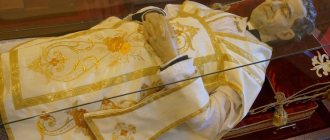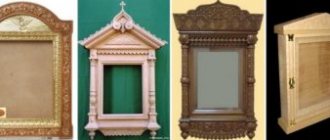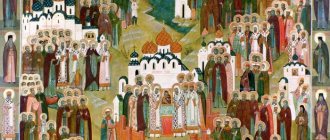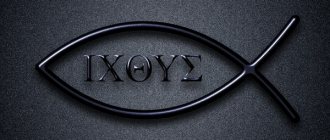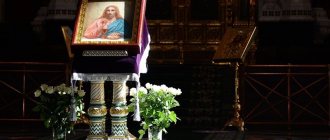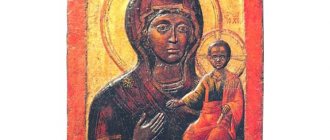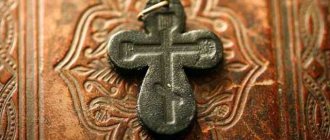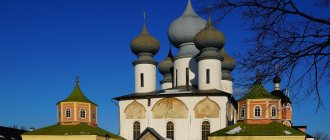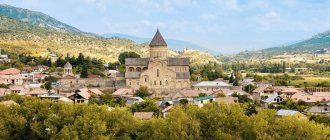- How did the relic appear?
- What does the icon of All Saints look like?
- What is the significance of the shrine?
- How and when do they pray in front of the icon?
- Prayer to All Saints
Every Christian has a personal heavenly protector who accompanies you throughout your life. But what if you don’t know which ascetic to turn to? In this case, the icons of All Saints come to the rescue! Photos and their meaning, as well as interesting facts about unique images, are collected in this article.
How did the relic appear?
This icon is inextricably linked with the Day, or the Council of All Saints. In Orthodoxy it is celebrated on the 8th Sunday after Easter, but in Catholicism this holiday falls on November 1st and has the highest rank of celebration. However, such dates were established not so long ago.
The first mentions of the holiday are found in calendars of the IV-V centuries. It is believed to be a reimagining of Celtic Samhain, when pagans communed with the spirits of departed ancestors. At the beginning of the 7th century, when Pope Boniface IV turned the Greek temple of the Pantheon into the temple of the Virgin Mary and God's saints, this celebration took place on May 13. And in the middle of the VIII century. Gregory III moved the day of honoring the righteous to November 1. A century later, this date became common to all churches.
But special relics in memory of the righteous, martyrs and ascetics began to be created a little later. The earliest surviving work is a miniature from the sacramentary (a collection of texts that were recited during the Mass) of the 10th century. – You can see a photo of the icon in the library of the University of Göttingen (Germany). Gradually, such images penetrated into Eastern Christian culture - for example, there are many frescoes of a similar theme in the Athonite monasteries. These drawings are also present in the Old Believer chronicles. In the West, similar paintings were painted by Fra Beato Angelico, the van Eyck brothers, and Albrecht Durer.
“Adoration of the Lamb” (Ghent Altarpiece, van Eyck brothers), 2nd half. 15th century
Saint Nicholas the Wonderworker
Among Christians all over the world, Saint Nicholas the Wonderworker of Myra of Lycia enjoys extraordinary respect. He is known as the patron saint of sailors and travelers. With the power of his Grace, the saint provides assistance to all those in trouble and difficult life situations. The icon of St. Nicholas the Wonderworker is an integral part of every church iconostasis. For most believers, it is included in their home congregation.
Love for him is not accidental. Throughout his earthly life, he fought for the truth, healed the suffering, and set everyone a personal example of serving God. The saint's memorial day is celebrated not once a year, but three. The day of his death is celebrated on December 19. People call this holiday “Winter Nikola”. Birthday - August 11 - is called "Nikola's summer". In addition, a holiday has been established on May 22. This is a memory of how in 1087 his honest relics were transferred from Greece to the Italian city of Bari, where they are kept to this day.
What does the icon of All Saints look like?
The Icon of All Saints arose under the influence of the “Revelation of John the Theologian”. The prophet talks about people standing at the throne of the Creator and forever singing His praises. They “came out of great tribulation; You have washed your robes and made them white in the blood of the Lamb.” In other words, the relic is dedicated to both canonized righteous people and those who remained unknown, but earned the mercy of God through a virtuous life or feat for His glory.
However, this also makes the iconography of the image extremely changeable and unstable. On the first lists, Jesus Christ was in the center, and around Him were kneeling angels and saints of the Lord. In the XIV century. A different story developed - now the relic consisted of two spheres. In the inner one the Trinity sat (sometimes together with the Mother of God and John the Baptist), and the outer one was filled with figures of the apostles, passion-bearers and miracle workers, divided according to hierarchical ranks. Below, paradise was captured - green tabernacles, among which were the Old Testament forefathers (Abraham, Isaac and Jacob), as well as the thief crucified with the Savior.
God's help through the prayers of the holy saints for us
However, it would be a mistake to believe that this or that saint has a purely narrow focus in his petitions to God. Of course no. This division is very conditional. The Lord God helps us, in His holy Will, to incline our ears to the prayers of certain saints for us. They themselves are not given the power to perform miracles, but they are intercessors and “conductors” of these miracles. Since the topic of conversation is icons of saints and their meaning, let us turn to some of the most famous and revered images in the Orthodox world.
What is the significance of the shrine?
Such an image seems to transport the viewer to the Heavenly Kingdom, filling the soul with harmony, happiness and grace. It symbolizes spiritual improvement, getting rid of vices and passions, getting closer to God. The meek, but at the same time strict views of the ascetics call on you to follow their example, keep the Lord's commandments, exalt the Christian faith and show mercy to your neighbors.
In addition, such a relic personifies the Triumphant Church - all the righteous who have found a new existence for the glory of the Creator. This congregation is led by Jesus Christ himself, so it is free from strife, social differences and misunderstandings.
Blind Elder Matrona
Almost every church in our capital has an icon of St. Matrona of Moscow. She is revered here in the same way as St. Xenia the Blessed in St. Petersburg. To a woman who was blind from birth, the Lord sent down to her the gift of working miracles, and the saint became widely known for this even during her earthly life. And although her life was very difficult - revolution, war, political repression, and also her own physical blindness, she managed to rise to the unattainable heights of the spiritual feat of love, patience and self-denial.
The icon of Saint Matrona helps from many troubles and misfortunes. People turn to her in case of family problems and troubles at work. She is asked to protect her from both evil people and natural disasters. Just as in the days of her earthly life Saint Matrona was responsive and unfailing in helping people, so now she helps everyone who prays before her gracious icon. The Orthodox Church celebrates her memory on May 2.
LiveInternetLiveInternet
Quote from message Zlatkovskaya_Valentina
Read in full In your quotation book or community!
The most revered icons in Russia
The most revered icons in Russia
Quote from Ksyushichek's message
Read in full In your quotation book or community!
See also: Orthodox icons * 30 most famous icons in Russia
Many parishioners, when they cross the threshold of the temple, purposefully approach the desired icon and pray to the holy image. Do you know what these famous Orthodox icons are and their meaning, what they look like, who is depicted on them? And also - what prayers are associated with them? Before going to church, it is better to study the rules of behavior, and at least know about the holy faces.
What distinguishes the Orthodox faith from other branches of Christianity? This is the veneration of holy icons. Although they are not rejected in Catholicism and some other denominations, they are so widely recognized only in the Byzantine tradition. By the numerous faces that look out from each wall and decorate the altar, it is easy to distinguish an Orthodox church from any other. There are thousands of officially recognized images; the Mother of God alone has more than 600, and there are also non-canonical ones. But how to navigate in such diversity? Why are icons needed? Officially, the dogma (truth that cannot be doubted) about the veneration of icons was established in 787, at the 2nd Council of Nicaea. Before this time, the use of images had long been practiced in churches. The first images of the Lord Jesus Christ, saints and the Mother of God have been known since the 2nd century. According to church tradition, the first icon painter was one of the evangelists, namely St. Luke. Famous Church Fathers - Basil the Great, John Chrysostom, John of Damascus - encouraged painters to depict the exploits of martyrs for the faith. But not everything was so simple. For example, Eusebius of Caesarea believed that man is not able to reflect the divine nature of Christ. Who is depicted in consecrated images: - Trinity (in the form of angels); — Lord Jesus Christ in his human incarnation; — Mother of God; — Angels and other heavenly powers; - Righteous people, martyrs, saints, etc. Church icons have a very specific purpose. This is not a decoration at all, not a reminder of eternal torment for sinners. Looking at them, believers should remember the prototypes and cultivate in their souls a feeling of love for the Creator and the saints. How to pray correctly in front of an icon Most people are of the opinion that it does not matter which saint to pray to, the main thing is that faith comes from a pure heart. After all, a person offers prayer words not to the icon, but to the one who is depicted on it. There are certain rules associated with the prayer process: 1. To attract God's blessing, you must stand in front of the shrine. You need to stand as straight as possible. 2. After prayer you need to kiss the image. In this way a person expresses respect to God. 3. Then you must cross yourself three times. It is possible to put candles - if desired. When you ask the Lord for help, your thoughts should be bright. Forgive all the people who have offended you.
Semistrelnaya
There are a lot of icons in the spiritual world, and each of them is associated with a specific prayer. Let's pay attention to the meaning of the most famous shrines. “ Seven Shot ” is one of the most powerful icons. A rather rare type of image where the Virgin Mary is shown alone. It is believed that this is the moment before the birth of the Savior. Seven blades are aimed at her heart. 7 is a symbolic image of completeness, that is, the Mother of God knew suffering and pain to the fullest. The swords represent Mary’s mental anguish in those moments when Christ went on the Way of the Cross and then died for human sins. What you should know about it: 1. If a person is not feeling well, then he comes to this icon to ask for protection and help. 2. The image of the Mother of God protects from envious people, from damage, the evil eye and curses of everyone who wears a chain with her image. To reconcile warring parties, as well as for family understanding, peace and quiet in the home, it is necessary to pray to this relic. 3. When a person needs to perform an important task, the image of the Virgin Mary will support him. In a house, it is recommended to place such an icon opposite the door, so that it can “see” the eyes of all people entering the room. Before installing the holy relic above half the wall, it is necessary to read a prayer service. After some time, you can notice that the person who has evil thoughts has stopped coming to the house. 4. Our Lady is a protector from the criminal world. If you have problems with your boss, then the icon of the Virgin Mary, which you take with you to work, can protect you from quarrels in the team.
Inexhaustible Chalice
It is of Byzantine origin. The exact time of writing is unknown. To this day, only copies have survived, which are stored in the monasteries of the city of Serpukhov. It was there that he turned at the end of the 19th century. a soldier dying from the sin of drinking wine. He dreamed of an elder and ordered him to go to the monastery. Although the man’s legs were already giving out, he trudged to the monks with the last of his strength. He managed to find an image of the Most Pure One. After the prayer service, the soldier received complete liberation from his craving for wine, his legs were healed. Since then, the sufferers have flocked to Serpukhov. And today many men and women susceptible to alcoholism or drug addiction come to the monastery. Many receive healing, return to their families, find work and arrange their lives. There is a cup in front of the Virgin Mary, with Christ in it. The Mother of God prays with raised hands, both looking directly at the believers. The composition is very beautiful, completely symmetrical and reminiscent of the perfection of the Lord, of His sacrifice for the whole world. Most often, before the “Inexhaustible Chalice” they ask for deliverance from obsession with alcohol, drugs and other addictions. An icon with the image of the Mother of God should be placed at the head of a person who abuses alcoholic beverages or is fond of gambling. There are known cases where a relic helped speed up the process of buying and selling a home. Parents whose children have grown up pray to Our Lady.
Healer
The icon depicts the Mother of God standing at the bedside of a sick cleric. “Healer” is an icon of the Mother of God that protects a person from mental as well as physical illnesses. Prayer: Like a bright Star, Your holy image, O Healer, shone with Divine miracles. Grant us, Mother of God Mary, healing of mental and physical illnesses, salvation and great mercy.
Unexpected Joy
Those who need spiritual strength turn to the “Unexpected Joy” icon. Also, prayer from this shrine helps pregnant women to bear and give birth to a healthy child, to preserve marriage and family harmony. Our Lady supports parents whose children have taken the wrong path. People who have hearing-related diseases pray to this saint.
Three-handed
The “Three-Handed” Icon of the Mother of God is truly special. The thing is that a third hand is depicted in its lower part. She can be either the third hand of the Mother of God or an independent element. Looking at the image, you can see that the central part of the image is reserved for the Baby Jesus. He sits in the arms of the Mother of God. If you look closely, you can understand that he blesses with his hand everyone who is in front of the icon. And the Mother of God herself points to her Baby as the path to Salvation. The image itself is honorable and respected, and the entire Christian world knows about its healing properties. They ask for help from the Holy Face of the Most Pure: - for protection from enemies; - when there is a threat to home or family well-being; — to contribute to increasing well-being; - for healing from diseases; — wishing health to your family or friends. “Three-handed” is asked to cure diseases of the limbs and eyes. In addition, this icon promotes and patronizes those who engage in any craft.
Quick to Hear
The Icon of the Mother of God Quick to Hear is an ancient miraculous face that is located in the Dochiar Monastery on Holy Mount Athos. It was written after receiving the blessing of the Athonite founder of the Dochiar monastery in the 10th century, and its name was given only in the 17th century, when the first miracle was performed. The painting of the face of the “Quick to Hear” dates back to the 10th century. The shrine itself depicts the Virgin Mary with a baby sitting on her left hand. The God-Infant clutches a scroll in one hand, and blesses people with the other. Another interesting detail is that the child’s heel is always directed towards the praying people. The holy image can help all people with a transparent heart who need support and protection. The image is also used by the servants of the Lord as a way to expel evil spirits from a person. And in the old days they prayed to the face during various tragic events, in order to save lives. The icon also helps to heal from diseases such as:
- cancerous tumors;
- blindness;
- immobilization of limbs.
Pregnant women pray to this image for the birth of a healthy baby.
Seraphim of Sarov
A famous elder of the Russian land, who during his lifetime was honored with a visit from the Mother of God. He was not educated, did not write works and did not preach sermons. But everyone knew and loved Father Seraphim. With wise spiritual eyes, he saw through each visitor. But he never condemned, but only instructed with kind words. The monk said that the purpose of human existence is to find the Holy Spirit. For this, the main thing is consistency and faith. Father even composed a special prayer rule for those who work hard throughout the day. He himself communicated with the heavenly inhabitants a lot, interceding for the human race. When the elder was alive, many looked to him for support and consolation. This continues even after his departure to another world. It will help disperse the darkness of despair, gain spiritual strength, and get rid of serious temptations. The Monk Seraphim is capable of driving away physical ailments. Helps to successfully conduct trading business - but only for those people who do not try to “cheat” their neighbor. “Seraphim of Sarov” is highly revered in Russia. A prayer said at this shrine also helps with diseases of the spine and legs.
St. George the Victorious
The image of the Great Martyr is considered one of the most revered shrines, and he also personifies the intercessor for believers whose life has anything to do with military affairs, but he can also protect landowners. The divine face can be found on some city flags and even on coins. The shrine, where a warrior kills a snake on horseback, personifies the extraordinary nobility and greatness of the displayed military courage. This shrine can be addressed in a prayer service to all Orthodox Christians who have connected their lives with the defense of their homeland. They are called to the Saint to petition for intercession in military conflicts, and parents whose sons have been called to service also pray before the face, so that the image will protect them from all difficulties, and the service will go well. “St. George the Victorious” protects everyone involved in dangerous work.
Nikolai Ugodnik the Wonderworker
On this shrine, the miracle worker is depicted waist-deep, holding the Gospel in his left hand and blessing with his right. His face is present in many homes of Orthodox Christians, thereby protecting them from troubles, and also takes care of family wealth and well-being. Here's how the miraculous face helps: 1. Protects wanderers and sailors. Even during his lifetime, the saint could stop storms and other bad weather on the way through prayer. According to some legends, young Nikola was able to resurrect a sailor who had fallen from the mast; he also slept another sailor on the way to Myra from Alexandria; 2. Protects the face of merchants and children. The patron always loved children very much, and responded well to the prayers of mothers for their children; 3. The icon of St. Nicholas the Wonderworker also helps in the reconciliation of warring parties, protects from enemies and is the patron of the army. During his life, the Wonderworker was a good-natured person who could easily try on enemies. To this day, people turn to him in prayer for reconciliation; 4. They turn in prayer to the Saint and in search of their other half, and also ring the mobelin for the image and for marriage; 5. The face also helps those who want to reform, as well as innocently convicted people who are in prison. The miracle worker saves those who pray from captivity in prison and even from death.
Our Lady of Vladimir
“Our Lady of Vladimir” is the most revered icon in Rus' among the images of the Blessed Virgin Mary. Such important events as the coronation of kings and the election of high priests took place with the participation of this icon. Before the Vladimir Mother of God they pray for the healing of the soul, the health of the body and for demon-possessed people. Vladimirskaya helps to get pregnant and feed the child. According to legend, the icon was painted by the Evangelist Luke. Prayers to this shrine will help:
- reconcile the warring;
- heal a sinner from mental or physical illness;
- cast out a demon;
- instill kindness into evil hearts.
Burning bush
The oldest example can be seen today in the Armory; it dates back to the 17th century. A bush is a bush of thorns; one of the Bible chapters tells how the Lord appeared to Moses in a fiery bush. Symbolically, the fireproof bush represents the Queen of Heaven, who was able to maintain spiritual purity in the midst of a sinful world. “The Burning Bush” is an icon of St. Mary. She patronizes firefighters, she is asked to protect the home from fire, attacks by thieves, unfriendly visitors, as well as cleansing from sins. They also pray that the soul does not descend into hellfire. Helps doctors, pilots.
Iveron icon
Revealed in one of the Athos monasteries at the turn of the 10th and 11th centuries. It is believed that the face of the Most Pure One originally appeared on the board thanks to a miracle - the Virgin Mary washed herself and applied her face. This print was sent to Georgia along with the Apostle Andrew - hence the name (Iveria is Georgia). The Athos image was revealed in a pillar of fire. For a long time he protected the monks from enemy raids. The Mother of God with her right hand points to Christ as the only path to salvation. It gets rid of enemies, gives relief from bodily ailments and replenishes lost energy. Helps to gain strong faith, returns the lost to the righteous path. She protects the houses in which she is located - it is not without reason that she is also called the Goalkeeper. It will protect against fires and prevent theft.
Everlasting color
A very beautiful composition in which the Virgin Mary holds white flowers. On one of the Greek islands there is a tradition - on the day of the Annunciation, parishioners bring bouquets of fresh lilies to the temple. They remain in the temple until the end of summer, when another great feast of the Mother of God is celebrated - the Assumption. On this day, a miracle happens - dried lilies bloom again! “The Unfading Color” was written in memory of the wonderful events. The Blessed Virgin tenderly holds the Christ Child. He raises his right hand in a gesture of blessing. The Most Pure One bowed her head slightly towards her Son. In her right hand, the Queen of Heaven holds white flowers (sometimes grapes or scarlet roses are depicted, but it was the white lily that Archangel Gabriel presented to Mary on the day of the Annunciation). “Fadeless color” especially patronizes the female sex: - girls ask for a good husband; - married - about the gift of healthy children; — the Most Pure One helps to restore joy in life; - restores peace of mind. The Blessed Virgin protects families from strife, wards off temptations, and helps girls maintain purity before marriage.
Tenderness of the Blessed Virgin Mary
On this shrine, the Most Holy Theotokos is depicted at her happiest moment, even before the birth of her child, Jesus, but after the Annunciation. Against the background of the divine image, the Protector stands out with her enthusiastic facial features and bright image. The Virgin Mary is depicted with her arms crossed in a prayer gesture, her head slightly bowed and her eyes slightly lowered, which in turn is the personification of kindness, chastity and restraint. The Mother of God is sealed precisely when the angel Gabriel talks about what she is about to give birth to the Son of God. The miraculous face can essentially be considered female, which is why it is mainly aimed at protecting and helping the beautiful female half of humanity. The miraculous image of the Most Pure One helps: - free yourself from various ailments; - get rid of mental burdens, as well as overcome adolescence; - in conceiving a child, as well as in facilitating the birth process; — to touch evil hearts, to get rid of immoral thoughts; The image will help girls find a worthy person and bring happiness to life.
Kazan Icon of the Mother of God
The Kazan Icon of the Mother of God is considered an intercessor. If a person has problems at work or in his personal life, then he simply needs to pray to this image. Kazanskaya is also often included in triptychs along with the face of the Savior and St. Nicholas the Pleasant. If the person asking for help makes a pure request, then the guidebook will help him. A person with negative thoughts may not expect help. "Kazanskaya" blesses the newlyweds.
We ask for help in our home
If you are used to praying at home, and not in church, then you need to read the prayer in the morning: 1. Wash your face. Then cross your arms. 2. Try to free yourself from thoughts that depress and irritate you. It is important. 3. Light the candles, bow before the holy images, kneeling. Maybe on a towel. 4. Read the prayer service. You can use the Bible. 5. Say your request in words that come from your heart. Thoughts must be sincere.
Ostrobramskaya
The Ostrobramskaya Icon of the Virgin Mary helps married couples find love and happiness. Prayers near this icon will help protect the house from evil spirits and evil ill-wishers. A person will be able to get rid of depression. If you place the relic at the entrance to your home, then all enemies will stop visiting you. Then peace and prosperity will reign in your home. Most people claim that Ostrobramskaya helped them solve many problems.
Unbreakable Wall
The Mother of God is depicted with her hands raised to the sky, on a golden background in her full height. The main monastery of icons has always been the St. Sophia Cathedral in Kyiv. The image is located at the main altar above a mountainous place. The shrine of the Mother of God in the Cathedral of the city of Kaliningrad is very popular. Here you can constantly see a huge number of people asking. After all, it is believed that if you pray in front of Her image, your prayer will certainly be heard. Day of celebration: All Saints Sunday (first Sunday after Trinity). “The Unbreakable Wall” is an icon named in honor of the strength and fortitude associated with the image of the Mother of God that has survived wars and disasters. The image helps protect your home from disasters and illnesses. An icon can ward off troubles from your family, and your home will be avoided by ill-wishers, thieves and fires. It also helps to strengthen family well-being and happiness. The best place for the icon will be the wall opposite the doors through which guests enter.
Joy to all who mourn
Icon of the Mother of God of All Who Sorrow Joy is especially close to the heart of a believer, because many people throughout their lives face various difficulties, be it illnesses and weaknesses, poverty and adversity, sorrows and sorrows. One can find consolation only in the name of the shrine. It is known that a prayer service before a divine image helps people in the following ways: ■ Gives people in need the necessary benefits; ■ Brings comfort in grief, as well as in difficult life situations; ■ Heals physical and bodily diseases; ■ She protects traders on trips; ■ They pray to the face and for help in business; ■ Helps also with difficulties at work and in family life.
Great Martyr and Healer Panteleimon
The image of a handsome young man in a cloak can be found in any Orthodox church. Who is this young man? During his life, he was a doctor - he healed human bodies, and after his righteous martyrdom he became a saint. By his example, he inspired many to embrace Christianity. So the physical doctor became a spiritual doctor. But until now, believers throughout Russia and beyond its borders pray near the image in moments when they are burdened by illness. You can ask for healing from any ailment, not only physical, but also spiritual. The Great Martyr Panteleimon abandoned his brilliant career as a court physician - he was admitted to the imperial palace. All for the sake of helping prisoners and the poor for free - in the name of Christ. Envious people reported him, the young doctor was arrested, interrogated, and then brutally tortured. But the saint joyfully endured all the torment, glorifying the name of God. He voluntarily lowered his head on the block, his executioners cried. Having joyfully departed to the heavenly abodes, from there he continues to pray for us sinners. The healer is depicted with a spoon in his hand - it contains medicine. He wears a blue robe (a sign of the innocence of the soul) and a red cloak - a symbol of martyrdom. Panteleimon can be easily recognized by his light curly hair.
The Holy Trinity
The most famous composition was written by the righteous Andrei Rublev. He was able to express the most complex theological dogma about the Triune God, using images, perspective, and various small details. Each of them has its own deep meaning. Even the position of the hands, the tilt of the head of each Angel is not accidental. Such a shrine should be in a place of honor in any home where there are baptized people. The Lord is the source of life, our existence depends on Him. Daily prayers are read before the faces, and any request can be addressed to Jesus Christ, God the Father or the Holy Spirit: ■ for the success of good undertakings; ■ about the health and well-being of loved ones; ■ about solving everyday problems; ■ about the forgiveness of sins and the granting of salvation to the soul. The hypostases of Almighty God are depicted in the form of three Angels. Rublev captured the Trinity at the moment of the council, where the plan of Redemption is discussed. In the center, according to the church fathers, is the Father, to the left of those praying is the Son, and to the right is the Holy Spirit. On the table is a bowl, where the atoning Sacrifice is symbolically depicted. The Trinity icon is a shrine to which people turn for help. She helps those who cannot cope with difficult trials on their own to find the right path in life. Before this icon you should read a prayer for cleansing from sins that haunt you. It is believed that the prayer that a person says near this icon is a conversation directly with the Lord God.
It is important to know
This information should have helped you find out about the most famous Orthodox icons, tell you which saint and what request you should make to get rid of problems. Prayers will help you find peace, happiness and health. Thank the saints for your life and then you will find peace of mind and be successful.
Iconostasis at home
Since ancient times, there has been a tradition of creating an iconostasis at home. The first thing they did when entering a new house was to take an icon with them in order to protect its walls from evil and evil spirits. Sometimes their number was greater than in a small church, so the believers tried to protect themselves from troubles. It was believed that there should be three main icons in the apartment: the Savior, the Mother of God and St. Nicholas the Wonderworker. And as life progressed, they were supplemented with wedding, holiday, and images of patron saints.
On the day of baptism, everyone has their own intercessor, whose name he bears. In honor of such an event, it is customary to give measured icons. Of course, we are talking more about children here. It was believed that she could protect and protect her owner throughout her life if she turned to her with prayer and pure thoughts.
There are such concepts as ancestral and family icons. They are different in meaning and spelling. The first is passed down from generation to generation and can be very ancient. And the second contains images of saints of all family members, and in the center - the most revered saint.
History of icon painting
In the second half of the 17th century, when the “official” church moved away from the Old Orthodox faith, the Old Believers came out in defense of the Old Russian and Byzantine canon of painting icons. They rejected innovation and adhered to ancient traditions. Old Believers and Nikonians depicted the cross on icons in different ways. On the domes of churches in the hands of saints, the Old Believers depict an eight-pointed cross, and no others. As well as the image of new saints who are recognized by the Russian Orthodox Church after the collapse.
Old Believers always painted two fingers on their icons, and designated the abbreviation of Jesus Christ as “IS. HS." At the same time, Nikon’s innovation uses “IIS. HS" - the meaning of the name Jesus Christ.
Old Believers artists begin painting an icon by selecting a specially processed board (inlaid board), which is connected with a dowel. Linen fabric is stretched over it, which is primed, sanded, and only then begins to write. Painting an icon is a whole science, and the Old Believers also have a certain order, old traditions. Therefore, only tempera paints are used and mixing techniques are not allowed. Often boards are used with a dividing recess (ark). The image of the face is distinguished by dark colors, which is typical of Old Believers.
It is worth paying tribute to their work and efforts, because most of those ancient icons that have survived to this day are their merit. The most valuable samples are in private collections. And this is a great gift when exhibits that are several centuries old are given to churches or Orthodox museums.
The use of casting in the production of images
The Old Believers, who often wandered from one place to another, had images that broke, fell, cracked, and they came to the conclusion that cast icons, folding icons, and crosses would be more practical. Entire schools were created to teach this craft. Such icons were often small in size and had many inscriptions on the sides. Ornaments and patterns were made using glassy enamel.
On the famous icons of the Old Believers you can find the image of not one saint, but several at once. This was a kind of way for Old Believers to save money on purchases and the opportunity to sell more of them into one person. Therefore, up to 8 images of saints were placed on one icon. The unity of religion and way of life was fundamental for the Old Believers. People were baptized with the icon and were seen off on a long journey or their last journey.
Wedding couple
Those who have decided on the sacrament of wedding need to know that there is a certain set of icons that should be present when performing the sacrament. This is the image of the Mother of God (in the hands of the bride) and the Savior (in the hands of the groom). They are very symbolic and during the wedding they mean that the man takes on the role of the cross of family life, the so-called small church; the woman becomes a guardian and protector, bringing fidelity, goodness and the greatest maternal love.
It is customary to place them in a house on the eastern side: on the right side is the image of Christ, on the left - the Virgin Mary. In the old days, wedding icons were passed on as blessings from parents to children.
Church images
Coming to a cathedral, a temple or a church, many see paintings on the walls, an iconostasis, the altar gates, and icons all around. They all have different meanings, but the same meaning is to convey the request from the sufferer to God. Orthodox Christians make not only requests, but also gratitude. You may not know the names of the icons, but the images that are drawn on them speak for themselves. In the old days, when many were illiterate, they studied the Gospel in church using images. And at the same time, one cannot assume that the icons in the church are just pictures. Their purpose makes it possible to reveal to the world the invisible God, who appeared before believers in the form of Jesus. As Christ said about himself: “He who has seen Me has seen the Father.”
It is impossible to imagine a church without icons; they are an integral part of the entire space of the temple and indispensable participants in the service, as well as the Gospel.
Healing images
For the majority of those who are often or seriously ill, an icon is an opportunity to ask for help. And there are those whom it is customary to turn to in difficult times. Many believers know Panteleimon the healer and the Great Martyr Barbara, the wonderworkers Damian and Cosmas. When turning to the image of the Mother of God - the “Inexhaustible Chalice” icon - they pray for deliverance from addictions (drug addiction, alcoholism, smoking). The history of its origin dates back to 1878. An old soldier arrived from the Tula province to the Serpukhov convent with the goal of finding this icon and being healed. He suffered from heavy drinking and for this reason lost the ability to walk. A recurring dream brought him to this monastery, in which he saw an old man who ordered him to appear in this very place for healing.
He had to crawl 100 km from his house to Serpukhov. The Lady had mercy on him and directed him to the old woman’s house. The soldier stayed with her for two days, during which time the old woman helped him get a little stronger, smeared his legs with healing ointment, and then he walked further, leaning on a crutch. When he reached the monastery and told about his difficult journey to Serpukhov, he asked to be directed to the icon of the “Inexhaustible Chalice,” but no one knew about it. Hearing that the Mother of God herself was helping him, people went to look for her. The soldier went to the relics of the Monk Varlaam, who founded the monastery, and recognized him as the old man from his dream.
Meanwhile, in the corridor that connected the sacristy with St. George's Church, they discovered an old icon painted in the Byzantine style. The board depicted the Mother of God, and in front of her was the baby Jesus in a bowl. Turning the image back, the monastery servants saw the inscription: “The Inexhaustible Chalice.” She was immediately taken to the church and a prayer service was served, during which the soldier felt relief and left the walls of the monastery already healthy, and he no longer had the desire to drink alcohol.
